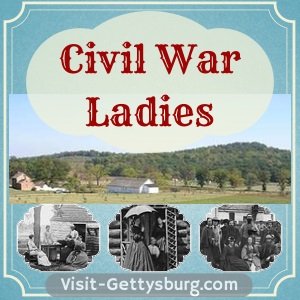Clothing During The Civil War
Ceremonious War Womens Habiliment
The Ceremonious War womens clothing outfits worn by the female citizens of Gettysburg and Victorian women visiting after the battle are hard for u.s. to imagine in the mod age of shorts and tank tops.


There were specialized Civil War dresses every occasion: mourning gowns, ball gowns, riding habits, etc.
The Hoop Skirt
Civil War Southern belles are all-time known for their hoops. Civil War ladies clothing and mode in the 1860s featured the hoop brim at its greatest width. The hoop extended slightly father out in the back than in the forepart.
Information technology took upwards to v yards of textile to make a Victorian hoop skirt.
The cloth supply to the Southward from northern mills was cut off during the war, and then some women made smaller skirts to relieve material and help the war endeavour. Or perhaps they recycled curtains every bit in Gone with the Current of air!
Practical Ceremonious War Dresses
While a hoop brim is a good outfit for Gettysburg Remembrance 24-hour interval on November 19th when ladies would have dressed up to hear Abraham Lincoln's Gettysburg Address, it is probable non what most citizens were wearing during the battle or while helping in hospitals.
Wealthy Victorian women wore several dresses each day. A "morning time wearing apparel" was plainer. An "evening apparel" was low on the shoulders, and suitable for a party. A "walking apparel" had a longer peltote (a blazon of jacket essential to the outfit) over it that matched the skirt.
On the other hand, working class women during the Civil State of war likely merely had two or three everyday dresses, i Lord's day best outfit, and maybe the newest everyday wearing apparel reserved for going to town or visiting people.
Layers of Civil State of war Womens Vesture
Here'south a list of the Civil State of war womens wearable that they wore starting side by side to the skin and working out in layers:
Layer 1
* Drawers (underpants) made of cotton wool or linen and trimmed with lace
* Chemise (long undershirt) usually made of linen
* Stockings held up with garters
Layer 2
* Corset or stays stiffened with whale bone
* Crinoline, hoop brim, or 1 or 2 petticoats (nighttime color if traveling due to mud and dirt)
Layer three
* Petticoat bodice, corset cover, or camisole
Layer 4
* Bodice
* Skirt, often held up with "braces" (suspenders)
* Belt
* Slippers made of satin, velvet, washed in knit, or crochet
Layer 5 (outerwear for leaving the firm)
* Shawl, jacket, or mantle
* Gloves or mitts
* Push button upwards boots
* Parasol
* Bonnet or hat
* Pocketbook or purse
* Handkerchief
* Fan sometimes made of sandalwood
* Watch pocket
A fine lady never painted her face (wore make up). Sometimes she did carry smelling salts incase she fainted. For festive occasions, immature ladies wore a nosegay of flowers.
Visit the Smithsonian website to see a vintage photo of a lady in Civil War womens clothing. (Opens in a new window.) There is also a color fashion plate from Godey'south Ladies Book, June 1862. Information technology was a mag that served the upper middle class, but those of lower status would certainly have been influenced by the Civil War ladies clothing fashions of high society and tried to imitate them.
I take collected some photos of Civil State of war dresses from the archives of the Library of Congress.
Colour Choices
According to mag manufactures from the era, a lady should choose colors based on harmony, simplicity, and influenced by nature.
We might consider some of their blossom inspired color combinations gaudy now; yet, they were afraid of beingness gaudy and looking like they were wearing Joseph's coat from the Biblical story, and so they stuck to two main colors in most ensembles.
Various styles of trim and braid were popular. Accessories for Civil State of war womens clothing were often covered in embroidery, equally the vintage patterns from Godey's Ladies Book and Peterson's Magazine bear witness.
More nearly Women'southward Gloves
Victorian modesty dictated that ladies should wear gloves when going out. She must accept nice clean gloves on for church or dancing. They were non worn at all times and removed for eating. Think of them as part of Civil War womens clothing outerwear or things put on when going visiting such every bit the shawl, cape, and bonnet.
Crochet mitts were popular in the 1840s, and so wearing them to an 1863 event is out of fashion. Peradventure someone erstwhile and clinging to her younger days would wear them, but white kid gloves extending to comprehend the wrist were the most popular and stylish gloves.
If yous crochet or knit and want to make something for your ensemble, why not make a snood? It was a lacy blazon of hairnet used to cover a bun.
Is at that place a pilus in your necklace?
Pilus jewelry was a special blazon of Ceremonious War jewelry used to remember loved ones separated by distance or death. It included the person's hair in rings, brooches, bracelets, necklaces, earrings, or even watch chains.
This accompaniment in Civil War womens article of clothing was a blazon of sentimental jewelry first given equally a token of friendship or dear, but every bit the Victorian era progressed, it became mourning jewelry.
Victorians had an obsession about hair being covered or worn up, and they were very careful virtually touching each other, hence the gloves. In this form, hair jewelry allowed men and women to bear on an intimate office of each other.
The pilus could exist clipped from the head, only many ladies had a pilus receiver on their dresser and emptied their brush into it.
Clothing During The Civil War,
Source: https://www.visit-gettysburg.com/civil-war-womens-clothing.html
Posted by: kelleynobster.blogspot.com


0 Response to "Clothing During The Civil War"
Post a Comment